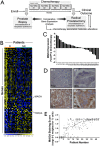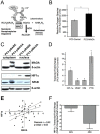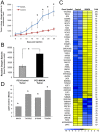Chemotherapy-induced monoamine oxidase expression in prostate carcinoma functions as a cytoprotective resistance enzyme and associates with clinical outcomes
- PMID: 25198178
- PMCID: PMC4157741
- DOI: 10.1371/journal.pone.0104271
Chemotherapy-induced monoamine oxidase expression in prostate carcinoma functions as a cytoprotective resistance enzyme and associates with clinical outcomes
Abstract
To identify molecular alterations in prostate cancers associating with relapse following neoadjuvant chemotherapy and radical prostatectomy patients with high-risk localized prostate cancer were enrolled into a phase I-II clinical trial of neoadjuvant chemotherapy with docetaxel and mitoxantrone followed by prostatectomy. Pre-treatment prostate tissue was acquired by needle biopsy and post-treatment tissue was acquired by prostatectomy. Prostate cancer gene expression measurements were determined in 31 patients who completed 4 cycles of neoadjuvant chemotherapy. We identified 141 genes with significant transcript level alterations following chemotherapy that associated with subsequent biochemical relapse. This group included the transcript encoding monoamine oxidase A (MAOA). In vitro, cytotoxic chemotherapy induced the expression of MAOA and elevated MAOA levels enhanced cell survival following docetaxel exposure. MAOA activity increased the levels of reactive oxygen species and increased the expression and nuclear translocation of HIF1α. The suppression of MAOA activity using the irreversible inhibitor clorgyline augmented the apoptotic responses induced by docetaxel. In summary, we determined that the expression of MAOA is induced by exposure to cytotoxic chemotherapy, increases HIF1α, and contributes to docetaxel resistance. As MAOA inhibitors have been approved for human use, regimens combining MAOA inhibitors with docetaxel may improve clinical outcomes.
Conflict of interest statement
Figures





Similar articles
-
Molecular alterations in prostate carcinomas that associate with in vivo exposure to chemotherapy: identification of a cytoprotective mechanism involving growth differentiation factor 15.Clin Cancer Res. 2007 Oct 1;13(19):5825-33. doi: 10.1158/1078-0432.CCR-07-1037. Clin Cancer Res. 2007. PMID: 17908975 Clinical Trial.
-
Phase 1/2 study of preoperative docetaxel and mitoxantrone for high-risk prostate cancer.Cancer. 2010 Apr 1;116(7):1699-708. doi: 10.1002/cncr.24960. Cancer. 2010. PMID: 20143429 Free PMC article. Clinical Trial.
-
Docetaxel and mitoxantrone before radical prostatectomy in men with high-risk prostate cancer: 10-year follow-up and immune correlates.Anticancer Drugs. 2017 Jan;28(1):120-126. doi: 10.1097/CAD.0000000000000438. Anticancer Drugs. 2017. PMID: 27669423 Free PMC article. Clinical Trial.
-
Paclitaxel and docetaxel in prostate cancer.Hematol Oncol Clin North Am. 2001 Jun;15(3):525-45. doi: 10.1016/s0889-8588(05)70230-6. Hematol Oncol Clin North Am. 2001. PMID: 11525295 Review.
-
Which drug combination for hormone-refractory prostate cancer?Expert Opin Pharmacother. 2005 Apr;6(4):667-70. doi: 10.1517/14656566.6.4.667. Expert Opin Pharmacother. 2005. PMID: 15934892 Review.
Cited by
-
Predicting therapeutic drugs for hepatocellular carcinoma based on tissue-specific pathways.PLoS Comput Biol. 2021 Feb 9;17(2):e1008696. doi: 10.1371/journal.pcbi.1008696. eCollection 2021 Feb. PLoS Comput Biol. 2021. PMID: 33561121 Free PMC article.
-
Monoamine oxidase isoenzymes: genes, functions and targets for behavior and cancer therapy.J Neural Transm (Vienna). 2018 Nov;125(11):1553-1566. doi: 10.1007/s00702-018-1927-8. Epub 2018 Sep 27. J Neural Transm (Vienna). 2018. PMID: 30259128 Free PMC article. Review.
-
The Antiproliferative Effects of Flavonoid MAO Inhibitors on Prostate Cancer Cells.Molecules. 2020 May 11;25(9):2257. doi: 10.3390/molecules25092257. Molecules. 2020. PMID: 32403270 Free PMC article.
-
Molecular Investigation of the Antitumor Effects of Monoamine Oxidase Inhibitors in Breast Cancer Cells.Biomed Res Int. 2023 Oct 5;2023:2592691. doi: 10.1155/2023/2592691. eCollection 2023. Biomed Res Int. 2023. PMID: 37841082 Free PMC article.
-
The highs and lows of monoamine oxidase as molecular target in cancer: an updated review.Mol Cell Biochem. 2025 Jun;480(6):3225-3252. doi: 10.1007/s11010-024-05192-w. Epub 2024 Dec 23. Mol Cell Biochem. 2025. PMID: 39714760 Free PMC article. Review.
References
-
- Tannock IF, de Wit R, Berry WR, Horti J, Pluzanska A, et al. (2004) Docetaxel plus prednisone or mitoxantrone plus prednisone for advanced prostate cancer. N Engl J Med 351: 1502–1512. - PubMed
-
- Petrylak DP, Tangen CM, Hussain MH, Lara PN Jr, Jones JA, et al. (2004) Docetaxel and estramustine compared with mitoxantrone and prednisone for advanced refractory prostate cancer. N Engl J Med 351: 1513–1520. - PubMed
-
- Shannon C, Smith I (2003) Is there still a role for neoadjuvant therapy in breast cancer? Crit Rev Oncol Hematol 45: 77–90. - PubMed
-
- O'Connell MJ (2004) Current status of adjuvant therapy for colorectal cancer. Oncology (Williston Park) 18: 751–755 discussion 755–758. - PubMed
-
- Dreicer R, Magi-Galluzzi C, Zhou M, Rothaermel J, Reuther A, et al. (2004) Phase II trial of neoadjuvant docetaxel before radical prostatectomy for locally advanced prostate cancer. Urology 63: 1138–1142. - PubMed
Publication types
MeSH terms
Substances
Associated data
- Actions
Grants and funding
LinkOut - more resources
Full Text Sources
Other Literature Sources
Medical
Molecular Biology Databases
Research Materials

